Forty-two years ago, the first JCB Loadall telescopic handler was introduced, leading the way in mechanising materials handling.
The first model, launched in 1977, was the JCB 520, a two-wheel-drive machine capable of lifting 2.48t and having a maximum boom height of 6.4m.
Following a record-breaking year of Loadall sales in 2018, selling 240,000 units, JCB recently launched the new Series III Loadall range with Command Plus cabs.
Previewed at Lamma in January, the new Series III range comprises of four models with bewtween 100kg-200kg increased load capacity over their predecessors.
The redesigned one-piece, fully welded chassis offers further strength thanks to thicker side plates accommodating this increase in load capacity.
This increase along with the cab facelift is warmly welcomed by customers.
The range will come with four different levels of specification – AGRI, AGRI Plus, AGRI Super and AGRI Pro.
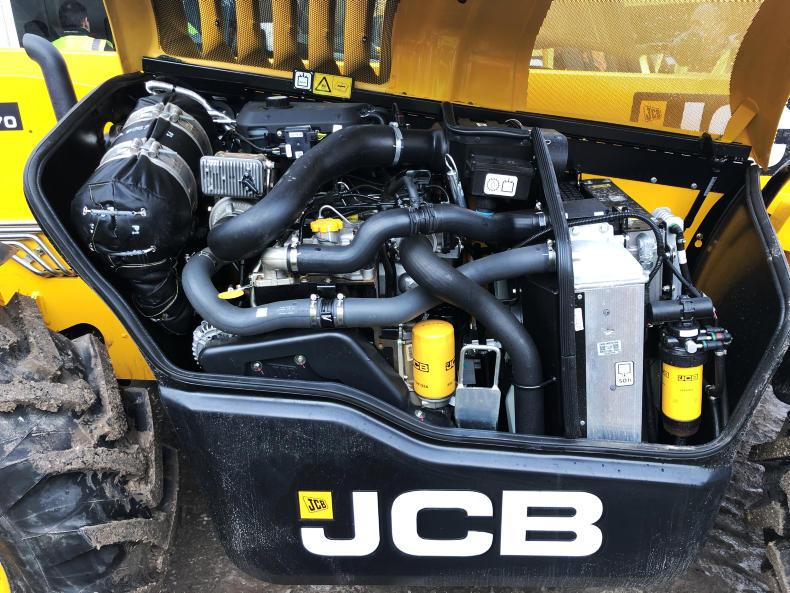
The JCB EcoMAX engine remains unchanged. But changes can be seen to the all yellow bonnet and JCB branding embossed into the lower cover
The company says £8m (€10.5m) has been invested in creating the new III series range, £6m of which went into the design of the latest cab.
The cab had remained unchanged for over a decade, give or take the small change here and there.
JCB noted that the new machines have undergone 50,000 machine test hours as well as 10,000 in-seat operating hours.
Command Plus Cab
The most obvious change distinguishing the latest Series III Loadall telescopic handlers is the Command Plus cab.
The new fully-clad cab proves much quieter, offering more space thanks to its 145mm longer and 35mm wider dimensions.
It remains only slightly bigger in size than before thanks to the relocation of the windscreen washer reservoir, previously mounted in front of the cab.

The all new Command Plus cab has many attributes from the other JCB lines such as the Fastrac and wheeled loader ranges. The dynamic tilt away steering column is an example of this.
One-piece multi-radius curved glass sweeps over the operator’s head, combining the windscreen and roof window.
All these features along with the low-set dashboard and angled roof crossbars increase operator visibility when viewing the boom at reach, which the company claims contributes to an overall 14% increase in all-round visibility.
The new Series III offers frameless mirrors further recessed into the machine to avoid damage.
The redesigned moveable grab handles allow for easier access to the cab, combined with the push-away steering column for easier entry and exit.
Once seated, although somewhat further back than before thanks to the tilt-away steering column, familiarity with other JCB products can be seen.
This is done as part of JCB promoting a common control theme throughout JCB Fastrac tractors and wheeled loaders.
Control
Looking to the right hand side, users will note the larger more informative 7in digital display.
Machine functions and setup information is displayed in a clean crisp manner, whereby screens are navigated through using the armrest-mounted rotary encoder.
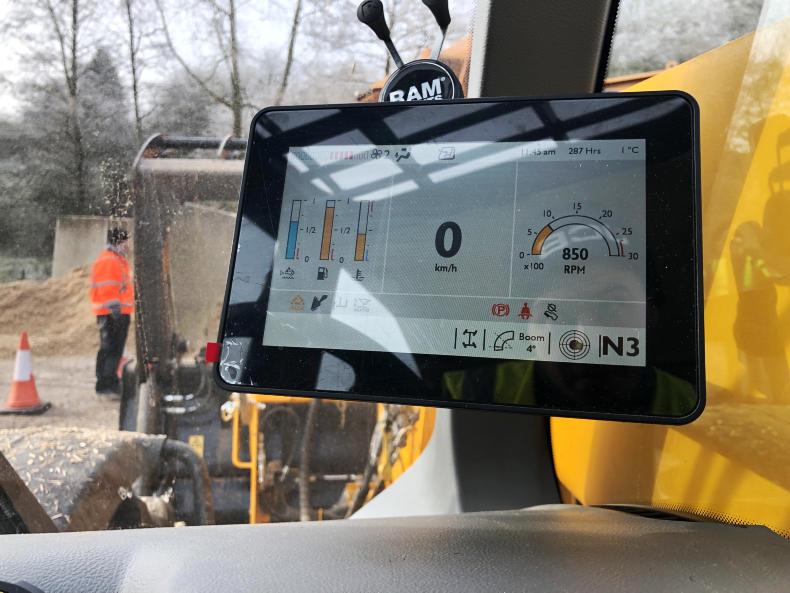
A seven inch 'tablet' like display keeps the operator informed of the machines status.
The previous array of rocker switches has given way to a cluster of rubber membrane switches, most of which are located alongside the armrest mounted joystick.
It’s clear JCB has really thought about the needs of the end user with the addition of little things such as more storage space, outside draining cup holders, phone holders, USB ports and bluetooth connectivity.
Transmission
The 109hp (81kW) model sees a new 40km/h Torque Lock four powershift transmission, claiming better performance and increased fuel economy while travelling and towing, in comparison to the regular 30km/h model.
The six-speed Torque Lock auto powershift transmission and JCB Dualtech VT hydrostatic/powershift transmissions continue unchanged.
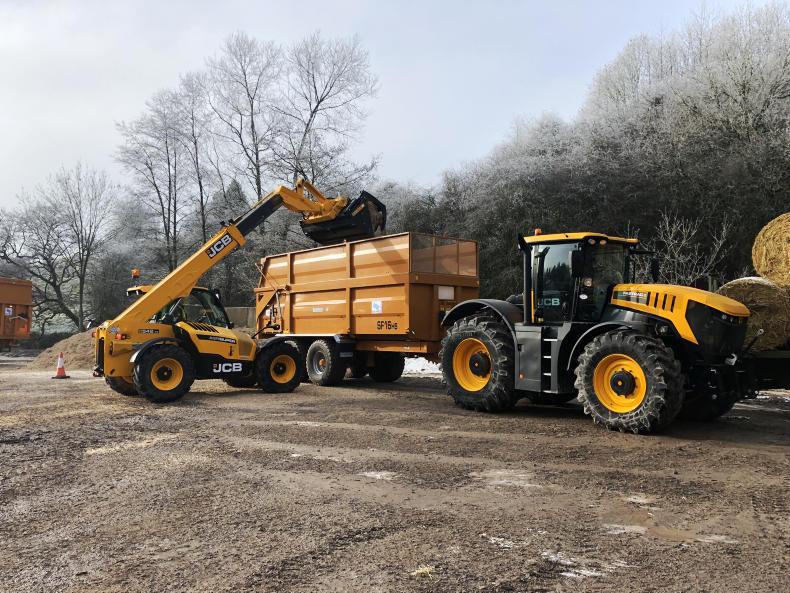
The range will consist of four different spec levels, AGRI, AGRI Plus, AGRI Super and AGRI Pro.
DualTech VT is essentially two transmissions in one. A hydrostatic module offering speeds from 0-19km/h, taking care of handling work, while the three-speed powershift takes care of speeds from 19-40km/h.
This transmission is only available to the Agri Pro models.
DualTech VT transmissions allow for Fleximode, providing independent engine speed and ground speed control, via paddle switches mounted in the end of the armrest for fingertip operation. The Agri Pro specification features ECO mode, allowing the machine to use less engine revs where full power is not needed.
Engine
JCB continues to use its four-cylinder 4.4l and 4.8l EcoMAX engines as before, serving up a power choice of 75hp, 109hp, 125hp and 145hp.
Mounted perpendicular to the boom, there is easy access to oil filters, oil reservoirs, air filters and radiators for regular maintenance and servicing.
Only the smallest 538-60 model can be fitted with the lower 75hp engine.

The JCB EcoMAX engine remains unchanged. But changes can be seen to the all yellow bonnet and JCB branding embossed into the lower cover
The bonnet enclosing the mid-mounted engine is now all yellow, aligning with the rest of the agricultural range.
JCB branding is pressed into the lower side of the engine cover and on the access panel at the back of the machine, unlike its predecessors.
Load carrying
As before, there is an option to add a rear pickup hitch to the machine, capable of lifting 2t and towing a respectable 32t.
The twin-line braking system and EBS (electronic braking system) plug are standard, while air brakes are expected to arrive as an option later in the year.
Hydraulic auxiliary venting is a new feature that can be activated from both inside and outside the cab to relieve auxiliary oil pressure, making attachment changeover easier.
Switching from auxiliary to quick hitch operation is now done from the cab, removing the need to get out.
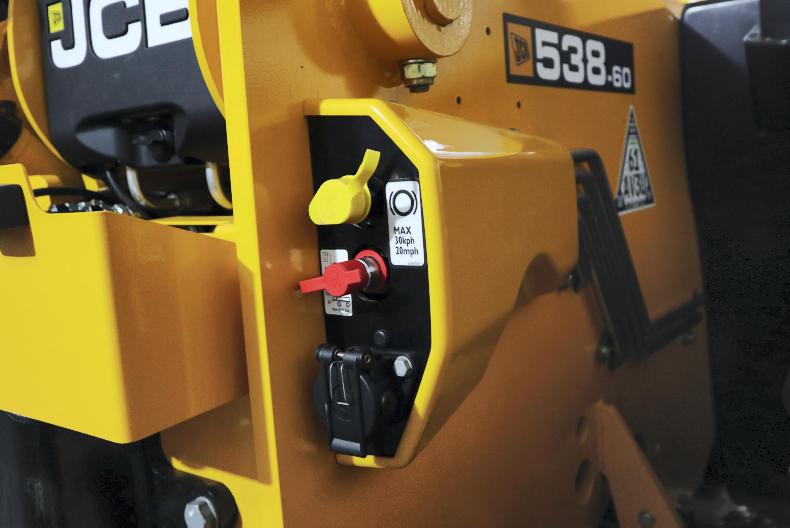
The dual line braking system with an EBS plug comes as standard
Forty-two years ago, the first JCB Loadall telescopic handler was introduced, leading the way in mechanising materials handling.
The first model, launched in 1977, was the JCB 520, a two-wheel-drive machine capable of lifting 2.48t and having a maximum boom height of 6.4m.
Following a record-breaking year of Loadall sales in 2018, selling 240,000 units, JCB recently launched the new Series III Loadall range with Command Plus cabs.
Previewed at Lamma in January, the new Series III range comprises of four models with bewtween 100kg-200kg increased load capacity over their predecessors.
The redesigned one-piece, fully welded chassis offers further strength thanks to thicker side plates accommodating this increase in load capacity.
This increase along with the cab facelift is warmly welcomed by customers.
The range will come with four different levels of specification – AGRI, AGRI Plus, AGRI Super and AGRI Pro.

The JCB EcoMAX engine remains unchanged. But changes can be seen to the all yellow bonnet and JCB branding embossed into the lower cover
The company says £8m (€10.5m) has been invested in creating the new III series range, £6m of which went into the design of the latest cab.
The cab had remained unchanged for over a decade, give or take the small change here and there.
JCB noted that the new machines have undergone 50,000 machine test hours as well as 10,000 in-seat operating hours.
Command Plus Cab
The most obvious change distinguishing the latest Series III Loadall telescopic handlers is the Command Plus cab.
The new fully-clad cab proves much quieter, offering more space thanks to its 145mm longer and 35mm wider dimensions.
It remains only slightly bigger in size than before thanks to the relocation of the windscreen washer reservoir, previously mounted in front of the cab.

The all new Command Plus cab has many attributes from the other JCB lines such as the Fastrac and wheeled loader ranges. The dynamic tilt away steering column is an example of this.
One-piece multi-radius curved glass sweeps over the operator’s head, combining the windscreen and roof window.
All these features along with the low-set dashboard and angled roof crossbars increase operator visibility when viewing the boom at reach, which the company claims contributes to an overall 14% increase in all-round visibility.
The new Series III offers frameless mirrors further recessed into the machine to avoid damage.
The redesigned moveable grab handles allow for easier access to the cab, combined with the push-away steering column for easier entry and exit.
Once seated, although somewhat further back than before thanks to the tilt-away steering column, familiarity with other JCB products can be seen.
This is done as part of JCB promoting a common control theme throughout JCB Fastrac tractors and wheeled loaders.
Control
Looking to the right hand side, users will note the larger more informative 7in digital display.
Machine functions and setup information is displayed in a clean crisp manner, whereby screens are navigated through using the armrest-mounted rotary encoder.

A seven inch 'tablet' like display keeps the operator informed of the machines status.
The previous array of rocker switches has given way to a cluster of rubber membrane switches, most of which are located alongside the armrest mounted joystick.
It’s clear JCB has really thought about the needs of the end user with the addition of little things such as more storage space, outside draining cup holders, phone holders, USB ports and bluetooth connectivity.
Transmission
The 109hp (81kW) model sees a new 40km/h Torque Lock four powershift transmission, claiming better performance and increased fuel economy while travelling and towing, in comparison to the regular 30km/h model.
The six-speed Torque Lock auto powershift transmission and JCB Dualtech VT hydrostatic/powershift transmissions continue unchanged.

The range will consist of four different spec levels, AGRI, AGRI Plus, AGRI Super and AGRI Pro.
DualTech VT is essentially two transmissions in one. A hydrostatic module offering speeds from 0-19km/h, taking care of handling work, while the three-speed powershift takes care of speeds from 19-40km/h.
This transmission is only available to the Agri Pro models.
DualTech VT transmissions allow for Fleximode, providing independent engine speed and ground speed control, via paddle switches mounted in the end of the armrest for fingertip operation. The Agri Pro specification features ECO mode, allowing the machine to use less engine revs where full power is not needed.
Engine
JCB continues to use its four-cylinder 4.4l and 4.8l EcoMAX engines as before, serving up a power choice of 75hp, 109hp, 125hp and 145hp.
Mounted perpendicular to the boom, there is easy access to oil filters, oil reservoirs, air filters and radiators for regular maintenance and servicing.
Only the smallest 538-60 model can be fitted with the lower 75hp engine.

The JCB EcoMAX engine remains unchanged. But changes can be seen to the all yellow bonnet and JCB branding embossed into the lower cover
The bonnet enclosing the mid-mounted engine is now all yellow, aligning with the rest of the agricultural range.
JCB branding is pressed into the lower side of the engine cover and on the access panel at the back of the machine, unlike its predecessors.
Load carrying
As before, there is an option to add a rear pickup hitch to the machine, capable of lifting 2t and towing a respectable 32t.
The twin-line braking system and EBS (electronic braking system) plug are standard, while air brakes are expected to arrive as an option later in the year.
Hydraulic auxiliary venting is a new feature that can be activated from both inside and outside the cab to relieve auxiliary oil pressure, making attachment changeover easier.
Switching from auxiliary to quick hitch operation is now done from the cab, removing the need to get out.

The dual line braking system with an EBS plug comes as standard







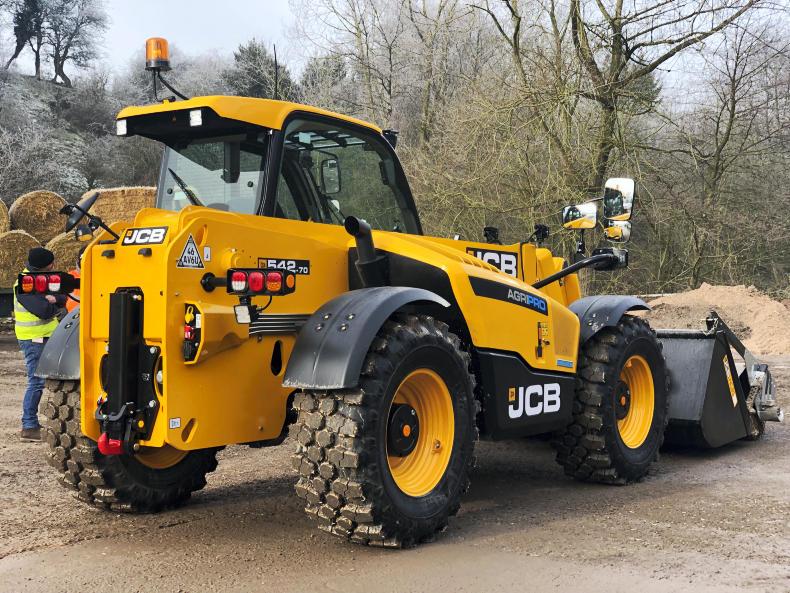




 This is a subscriber-only article
This is a subscriber-only article





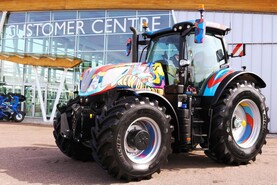

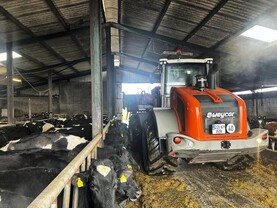
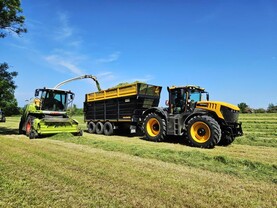
SHARING OPTIONS: